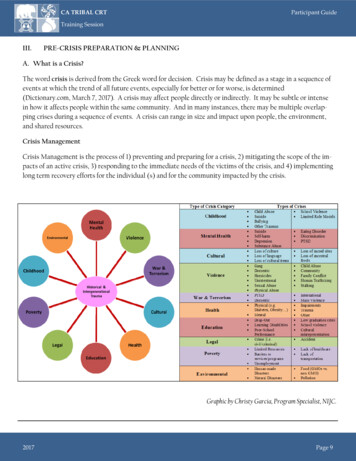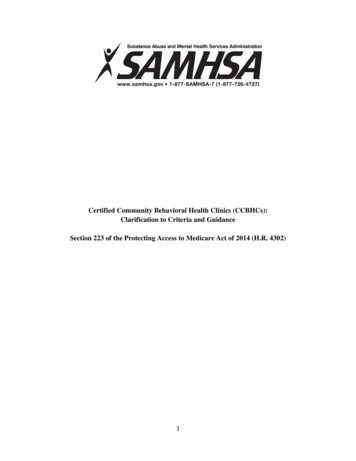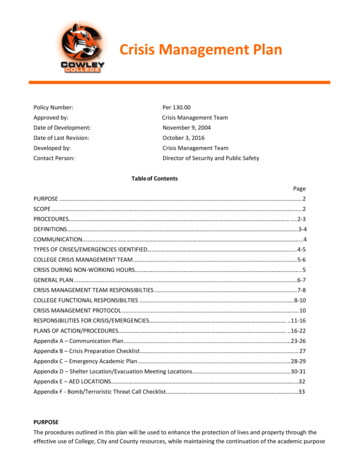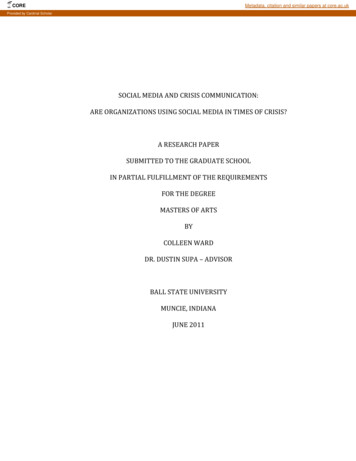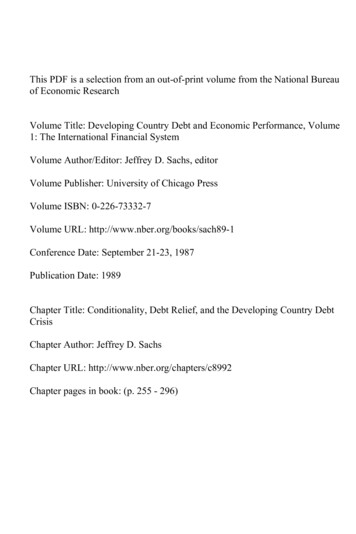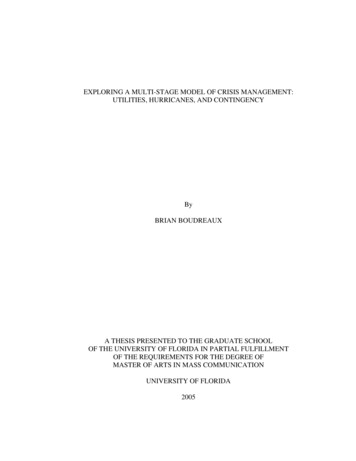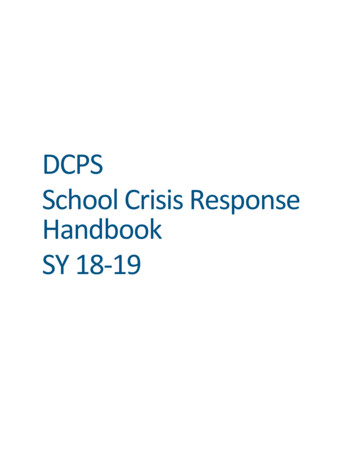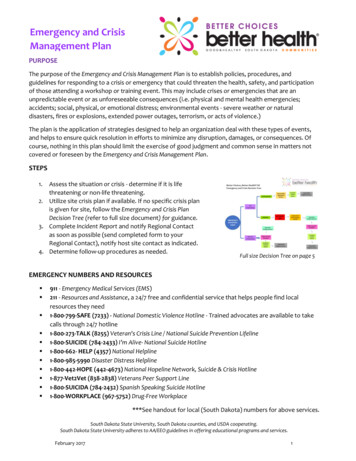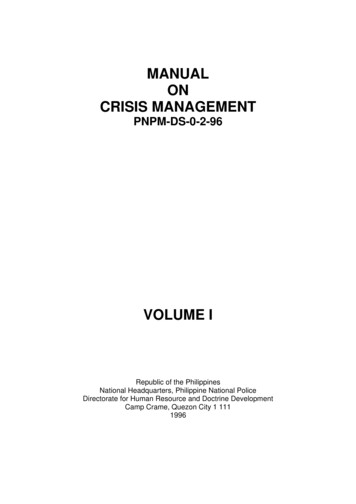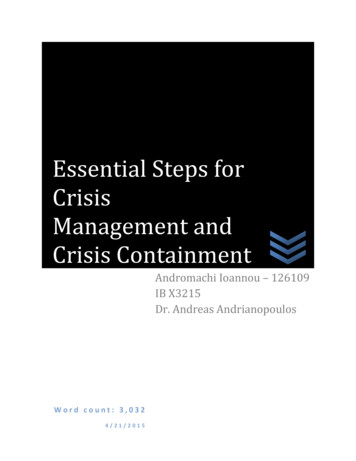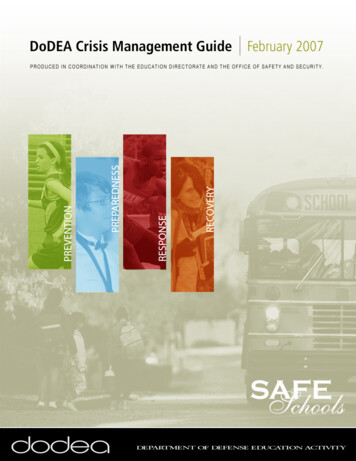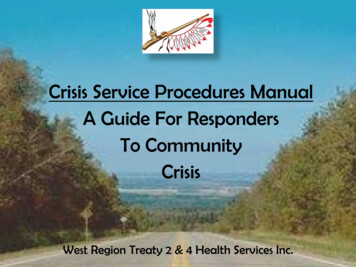
Transcription
Crisis Service Procedures ManualA Guide For RespondersTo CommunityCrisisWest Region Treaty 2 & 4 Health Services Inc.
Overview Brief introduction to West Region Treaty 2 &4 Health Services (WRTHS) – history,communities, programs and services,cultural programming MWT Project – Anishinabe Mekina MinoAyawin (AMMA) WRTHS Crisis Service Procedures Manual– a guide for responders to community crisis Case Study – an opportunity for participationand discussion2
About WRTHS West Region Tribal Council (WRTC) established in1979 following DIAND devolution process WRTC supported establishment of WRTC HealthDepartment in 1998 WRTC HD incorporated in August 2013 as WestRegion Treaty 2 & 4 Health Services (WRTHS) Inc.,with WRTHS Board of Directors as its overallgoverning body WRTHS provides advisory and direct services toon-reserve and off-reserve members Accredited in December 2015 by CAC for threeyears3
WRTHS Communities1. Ebb & Flow F.N. – Treaty #2, 18712. Skownan F.N. (Waterhen) – Treaty #2, 18713. O-Chi-Chak-Ko-Sipi F.N. (Crane River) –Treaty #2, 18714.5.6.7.Keeseekoowenin F.N. – Treaty #2, 1871Pine Creek F.N. – Treaty #4, 1874Rolling River F.N. – Treaty #4, 1874Gambler F.N. – Treaty #4, 18744
5
WRTHS Vision StatementTo reclaim the health of Anishinaabe byopening doors to healthy living for presentand future generationsWRTHS Mission StatementTo support West Region Anishinaabe toenhance and sustain healthy communities oftoday and tomorrow6
WRTHS Programs and Services: Counselling Services UnitCrisis and/or short term counsellingCritical incident response and de-briefingTraining, e.g. ASIST, MHFA for FN, Balancing HookWorkshops related to wellness, e.g. loss & grief, anger management, relationships, suicidepreventiono Advocate for clients, e.g. issues related to housing, home careo On-call during December breakoooo Addiction Services ProgramooooDirect client service and deliveryAdvisory service and support to community based NNADAP workers and programReferrals to treatment centres and/or other service providers and agenciesPost-treatment follow up and aftercare; relapse prevention; case management Tribal Nursing Programo Community Health Nurses in seven communities Home and Community Care Programo HIV/AIDS Education, Awareness, and Prevention Brighter Futures/Building Healthy Communities7
WRTHS Programs and Services: Environmental Healtho water safety; water inspection services Aboriginal Diabetes Initiative National Aboriginal Youth Suicide Prevention Strategy (NAYSPS) Indian Residential School (IRS) Resolution Health Support Programo IRS offices located in Dauphin and Brandono Ensure the health and safety of former IRS students during all phases of the IRSSettlement Agreement, including TRC eventso Ensure former IRS students and family members have access to appropriate supportserviceso Offer awareness/educational workshops and presentations Elder Advisory Serviceo Spiritual Advisor; Elders gathering Optical Serviceo quarterly on-site visits by an Optometrist, includes optician service Foot Care Service Medical Transportation Program Mental Wellness Team Projecto Anishinabe Mekina Mino-Ayawin8
Mental Wellness Team Project (MWT)Anishinaabe Mekina Mino-Ayawin (AMMA) - “Road to Good Health”Initiated in the Fall of 2009 through a Call for Proposals from FNIHBGoals: Increase access to a range of services including outreach, assessment,treatment, ceremony, counselling, case management, and referral Increase community engagement on mental wellness issues Increase peer supports, clinical supports and supervision to preventfront-line burnout through caseload sharing Improve treatment outcomes resulting from improved collaboration,better continuity of care, more appropriate and better quality services,and improved access to service Increase surveillance to detect mental health challenges and substanceuse disorders Ensure care providers are trained and supported to provide services atthe community level9
AMMA Community Teams Formed in 2010, membership includes: Team Lead,Alternate Lead, Elder, Youth, front-line workers,community members Multidisciplinary approach (includes family) Community owned, defined, and driven Enhances collaboration between community andexternal service providers Culturally safe Prevention to aftercare service Promote family/community supports Case management approach Terms of Reference Pamphlets; display boards;10
AMMA Tribal Team Supports AMMA Community Teams Multi-disciplinary team of professional andparaprofessional service providers with expertise inprevention & healing; treatment; education & training;family development; community development Provides advisory and coordinated services thatcombines traditional, cultural, and mainstreamapproaches to mental health challenges Membership includes WRTHS Spiritual Advisor,Program Coordinators, First Nation communityworkers, PMH mental health professionals, ClinicalSupervisor11
MWT Program Delivery Assist with immediate response to critical incidents Collaborate with all WRTHS programs and services Participate with WRTHS organized events, e.g. NAYSPS LiveForward youth gatherings Participate in community events – health fairs, schoolwellness days Provide training – e.g. Mental Health First Aid (MHFA) for FirstNations, Substance Abuse Subtle Screening Inventory(SASSI), Group and Individual Crisis Intervention Committee involvement – Parkland Mental Health PromotionCommittee, Co-Occurring Disorders Leadership Team,Committee Advocating for the Removal of Sexual Exploitation(CARE)12
MWT Program Delivery Promote and maintain service-to-service relationships throughongoing partnerships with Prairie Mountain Health (PMH),Mood Disorders Association of Manitoba (MDAM), CanadianMental Health Association (CMHA), and committeeinvolvemento Includes joint meetings with communities Regular AMMA Tribal and Community Team meetingsAwareness and prevention workshops, e.g. depressionConference presentationsContinue to address challengeso Stigma surrounding mental health issueso Funding Two successful evaluations completed:o Process – 2011o Immediate Outcomes - 201213
AMMA Wellness Gatherings Annual gathering of the seven AMMA Community Teams An opportunity for the teams to share information andexchange ideas Team reports include activity updates, successes, andchallenges experienced by each team in their community Guest speakers on topics requested by the teamsooooDr. Martin BrokenlegMental Health ActPersonal Health Information ActChild and Family Services Act14
Elders GatheringsSeptember 2014 – Elkhorn Resort, Wasagaming“O Shee Tah Dah” – Let’s Get ReadyAugust 2015 – Camp Wasaga, RMNPReclaiming Our Spirit – What can wedo?15
WRTHS Cultural ServicesSpiritual Advisors provide cultural support for the IRS Program: Teach and facilitate traditional healing practices, e.g.smudging, sweat lodge, and traditional medicines Available to the Tribal Team, AMMA Community Teams, andindividuals upon request via the established referral process Deliver workshops, e.g. traditional teachings Facilitate sharing circles/groups, e.g. men’s and women’sgroups Open and close meetings16
MWT Successes & ChallengesSuccesses: Strong program delivery Effective crisis response Partnerships and connections are maintained, including committeemembership Increased promotion has raised community awareness about mentalhealth challenges Crisis Service Procedures Manual (next section)Challenges: Busy work schedules; participation with other teams/committees; traveldistance affects meeting frequency and attendance Staff turnover Promotion – to further increase community awareness Stigma Funding17
Crisis Service Procedures Manual18
Crisis Service Procedures Manual The remainder of this presentation will outlinehow WRTHS approached the production of itsCrisis Service Procedures Manual As the process of this crisis manual developmentwas undertaken, several questions wereconsidered:o How do we best meet the needs of our communitiesin the event of a crisis?o Where do we begin?o Who should be involved during this process?o How much will it cost, in terms of time, printing costs,and training costs?19
Crisis Service Procedures ManualBackground: Original document produced by Dr. John Elias, Elias &Associates Consulting Inc., for the Cree Nation TribalHealth Centre, Inc., The Pas MB, in April 2002 Revised by WRTCHD in January 2003 with theassistance of Dr. Elias, in collaboration with WRTC FirstNation communities, to assist front-line wellness staffworking in WRTC First Nations 2003 revision was titled “Crisis Service ProceduresManual for Community Wellness Workers in theCommunities of the West Region Tribal Council”20
Crisis Service Procedures Manual Recognition in 2012 by WRTCHD staff that an updatedguide to an organized crisis response to crisis was required:o to support the communitieso to prepare the communities to effectively respond to criticalincident events Meetings to review and revise the manual began in 2013and continued through 2014 Used with permission, including permission to makerevisions Completed manual is copyrighted by WRTHS, February2015 Sent to the printer in March 201521
Crisis Service Procedures Manual The manual is a continuing effort to assist wellnessstaff working in WRTC First Nation communitiesrespond to social and emotional crises, by providingprocedures to follow and providing an outline ofresources to use The manual is not intended to replace or to provide asubstitute for any other policy, procedure, or planadopted by any of the First Nations within WRTC, or byWRTHS, e.g. an emergency response plan Other policies, procedures and plans in use bycommunities should be used to deal with such events,e.g. natural disaster (flood, fire), accident (motorvehicle, industrial)22
Crisis Service Procedures ManualAcknowledgements: Dr. John Elias – Elias & Associates Consulting Inc. Cree Nation Tribal Health Centre Inc. Health Canada, First Nation and Inuit Health Branch Klinic Community Health Centre WRTHS Staff – program managers, nurses,administrative WRTHS Board of Governance West Region Tribal Council First Nation Communitymembers WRTHS Spiritual Advisor23
Crisis Service Procedures ManualOrganized into urposeHow to Use This ManualPrinciples and Roles – e.g. confidentialityCrisis Management: Basic Theory & MethodsCrisis Service Procedures – step by step ways ofdealing with different kinds of crises8. Teamwork and Communications9. Confidentiality and Release of Information10. Record Keeping and Forms11. Follow-up12. Directory of Existing Resources24
Crisis Service Procedures ManualSection 7 – Crisis Service Procedures:A.B.C.D.E.F.G.H.I. Basic CounsellingRisk of SuicideDeath by SuicideLoss & GriefTraumaViolence and Abuse – includes bullyingNeglectSerious IllnessAddiction – includes co-occurring disordersCommunities may incorporate additional procedures, unique to theircommunity, dependent on their policies, procedures, or by-laws25
Crisis Service Procedures ManualOutline for each Procedure in Section 7:Background – basic information about the type of crisisAssessment – a list of important questions or tools tohelp get a true picture of the important details of thecrisis situationImmediate Goals – the immediate goals to be pursuedwhen intervening in the crisis at the community level26
Crisis Service Procedures ManualIntervention – guidelines on how to help,complete with a list of DO’s and DON’TsDO – practical things which a communitybased wellness worker can do to help anindividual, family, group, or communitythrough a crisisDON’T – includes a list of common mistakes,often with the best intentions, which may domore harm than good27
Crisis Service Procedures ManualRefer – suggestions about resources outside ofyour immediate work unit (health centre) towhom you could refer an individual or familyfor helpNotify – who should be notified about the crisisRecord – what to write about the crisis, theformat, forms, and where the report shouldbe filed28
Crisis Service Procedures ManualDistribution: WRTHSAMMA Tribal TeamAMMA Community TeamsHealth DirectorsChiefs & CouncilsHealth Board of Governance29
Crisis Service Procedures ManualTraining completed and planned: CISM Group and Individual Crisis Intervention, includesICISF certification – 2015 Applied Suicide Intervention Skills Training (ASIST) –ongoing Mental Health First Aid for First Nations (MHFA) –ongoing Workshops, e.g. bullying, lateral violence, angermanagement, grief counselling – ongoing Traditional Teachings by WRTHS Spiritual Advisor –ongoing safeTALK - planned30
What We Learned Developing a crisis manual is not a simple, straightforward process:o WRTHS is fortunate to have had a source documento Writes and re-writes Successfully produced a valuable resource for our communities Important to solicit contributions from a range of sources – individuals,service providers, agencies, and organizations – for input into the manual Importance of including PMH (regional health authority) and FNIHB aspart of any crisis response For certain crisis events, the assistance of other departments andagencies, or neighbouring First Nation communities, may be required Challenges remain:o shortage of funding required for training means identifying and securing otherfunding sources Important to acknowledge that every First Nation or organization isdifferent and will approach crisis response situations according to theircommunity’s needs31
Case StudyRefer to handouts: Scenario – Community Crisis Group discussion questions32
33
34
Thank YouMerciMeegwetch35
ContactJan Dewar-Catagas, BAMental Wellness Team Co-ordinatorjdewar-catagas@wrtchealth.comRenita Houle, BSW, RSW, ICASMental Wellness Advisorrhoule@wrtchealth.comT (204) 622-9400F (204) 622-944936
Crisis Service Procedures Manual Recognition in 2012 by WRTCHD staff that an updated guide to an organized crisis response to crisis was required: oto support the communities oto prepare the communities to effectively respond to critical incident events Meetings to review and revise the manual began in 2013 and continued through 2014
